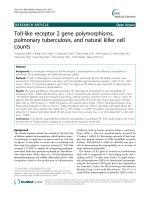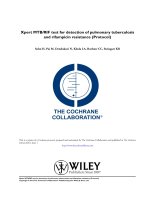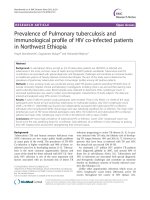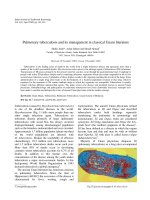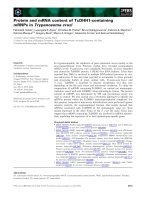Prevalence of Pulmonary tuberculosis and immunological profile of HIV co-infected patients in Northwest Ethiopia pdf
Bạn đang xem bản rút gọn của tài liệu. Xem và tải ngay bản đầy đủ của tài liệu tại đây (150.16 KB, 6 trang )
RES E AR C H A R T I C L E Open Access
Prevalence of Pulmonary tuberculosis and
immunological profile of HIV co-infected patients
in Northwest Ethiopia
Yitayih Wondimeneh
1
, Dagnachew Muluye
2*
and Yeshambel Belyhun
3
Abstract
Background: In sub-Saharan Africa, as high as 2/3 of tuberculosis patients are HIV/AIDS co-infected and
tuberculosis is the most common cause of death among HIV/AIDS patients worldwide. Tuberculosis and HIV
co-infections are associated with special diagnostic and therapeutic challenges and constitute an immense burden
on healthcare systems of heavily infected countries like Ethiopia. The aim of the study was to determine the
prevalence of pulmonary tuberculosis and their immunologic profiles among HIV positive patients.
Methods: A cross sectional study was conducted among adult HIV-positive patients attending HIV/AIDS clinic of
Gondar University Hospital. Clinical and laboratory investigations including chest x-ray and acid fast staining were
used to identify tuberculosis cases. Blood samples were collected to determine CD4+ lymphocyte count. A
structured questionnaire was used to collect socio-demographic characteristics of study subjects. The data was
entered and analyzed using SPSS version 16 software.
Results: A total of 400 HIV positive study participants were enrolled. Thirty (7.5%, 95%C I: 5.2-10.6%) of the study
participants were found to have pulmonary tuberculosis. In multivariate analysis, only CD4+ lymphocyte count
(AOR = 2.9; 95% CI: 1.002-8.368) was found to be independently associated with tuberculosis-HIV co-infection.
Individuals who had advanced WHO clinical stage were also statistically significant for co-infection. The mean CD4+
lymphocyte count of HIV mono-infected participants were 296 ± 192 Cells/mm3 and tuberculosis-HIV co-infected
patients had mean CD4+ lymphocyte count of 199 ± 149 Cells/mm3 with p value of 0.007.
Conclusions: We found high prevalence of tuberculosis-HIV co-infection. Lower CD4+ lymphocyte count was
found to be the only predicting factor for co-infection. Early detection of co-infection is very necessary to prolong
their ART initiation time and by then strengthening their immune status.
Background
Tuberculosis (TB) and human immune deficiency virus
(HIV) infections are two major public health problems
in many parts of the world. The prevalence of TB-HIV
Co-infection is higher worldwide and 90% of these co-
infected cases live in developing nations [1-3]. Tubercu-
losis is the most common opportunistic disease and
cause of the death for those infected with HIV [3]. Simi-
larly, HIV infection is one of the most important risk
factors associated with an increased risk of latent TB
infection progressing to active TB disease [4, 5]. In per-
sons infected with TB only, the lifetime risk of develop-
ing TB ranges between 10% and 20% [6, 7]. However in
persons who have been co-infected with TB and HIV,
the annual risk can exceed 10% [8-10].
An estimated 1.37 million HIV positive TB patients
were diagnosed globally in 2007, and around 80% of
them live in sub-Saharan Africa [11]. Tuberculosis and
HIV co-infections are associated with special diagnostic
and therapeutic challenges and constitute an immense
burden on healthcare systems of heavily infe cted coun-
tries like Ethiopia [12].
Unlike other opportunistic infections which occur at
CD4+ lymphocyte count below 200/mm3, active TB
occurs throughout the course of HIV disease [13].
* Correspondence:
2
Department of Medical Microbiology, School of Biomedical and Laboratory
Sciences, College of Medicine and Health Sciences, University of Gondar, P.O.
Box 196, Gondar, Ethiopia
Full list of author information is available at the end of the article
© 2012 Wondimeneh et al.; licensee BioMed Central Ltd. This is an Open Access article distributed under the terms of the
Creative Commons Attribution License ( which permits unrestricted use,
distribution, and reproduction in any medium, provided the original work is properly cited.
Wondimeneh et al. BMC Research Notes 2012, 5:331
/>Clinical presentation of TB in HIV-infected individuals
depends on the level of immunosuppression resulting
from HIV infection. In patients with relatively intact im-
mune function (CD4+ lymphocyte count >200/mm3),
pulmonary tuberculosis (PTB) is more frequently seen
than extra pulmonary TB [14, 15].
Ethiopia is among the countries most heavily affected
by the HIV and TB. The World Health Organization
(WHO) has classified Ethiopia 7th among the 22 high
burden countries with TB and HIV infection in the
world [16].
It is recognized that joint TB-HIV interventions will
clearly require additional funding to improve both TB
and HIV program performance and coverage, increase
testing and counseling, prevent mother to child transmis-
sion of HIV infection, provide community home based
care for people living with HIV/AIDS and provide anti-
retroviral treatment. Despite this needs, there is no ad-
equate and recent data in Ethiopia especially in this study
area. Therefore, the aim of this study was to determine
the prevalence of PTB among pre-antiretroviral treatment
(ART) HIV positive patients and their immunologic pro-
files which is important for health professionals and pol-
icy makers to make evidence based decisions.
Methods
Study design, period and setting
A cross sectional study was conducted from March 27 to
May 30, 2011 at Gondar University Hospital, Northwest
Ethiopia. Gondar University Hospital is a teaching referral
hospital located 720 km North West of Addis Ababa. It is
the only referral hospital for North West Ethiopia serving
a population of about 5 million coming from different
geographical locations surrounding it. The hospital pro-
vides inpatient and outpatient services, including care
and treatment for TB and HIV/AIDS patients with ARTs.
Patients being evaluated for ART initiation undergo a
routine medical examination, including screening for TB
disease and other opportunistic infections.
Source population and Study participants
The source populations for this study were all HIV posi-
tive individuals who have the access to be served in Gon-
dar University Hospital. The study participants were all
ART naïve HIV positive adult individuals who have vis-
ited ART clinic at Gondar University Hospital during the
study period. A total of 422 subjects were enrolled in the
study considering 95% confidence, 5% margin of error,
50% of prevalence of TB (since there was no previous es-
timate of TB among HIV infected individuals in the area)
and 10% contingency by using single proportion formula
[17]. Study subjects were selected using systematic sam-
pling technique from patient’s record in HIV/AIDS clinic
by taking patients registered in every 6
th
interval. Those
ART naïve adult HIV positive individuals who gave
informed consent and enough amount of blood sample
were included but Individuals who were on ART and
those with known chronic illnesses like diabetes mellitus
and hypertension were excluded from the study.
Data collection procedures
All subjects underwent TB screening which include: (1)
symptom screening and physical examination, (2) patients
having sputum production and clinical manifestations
were requested to provide three sputum specimens
(spot-morning-spot) for smear microscopy, and (3) chest
radiography. Study participants were interviewed about
the presence of clinical manifestations of TB. Socio-
demographic characteristics and other related risk factors
were collected using structured questionnaire by trained
nurses and physical examination was done by physicians.
Posterior and anterior chest x-ray (CXR) was done for
patients having sputum production and clinical manifes-
tations and interpreted. All patients having sputum pro-
duction and clinical manifestations provided 3 sputum
samples for smear examinations (spot-early morning-
spot). Sputum was collected in a pla stic leak-proof con -
tainer and smear was done for acid fast staining using
a direct Ziehl-Neelson (ZN) technique [18]. Five milli-
liter of venous Blood was aseptically collected in ethyl-
ene diamine-tetra-acetic acid (EDTA) tubes for CD4 +
lymphocyte count. The CD4+ lymphocyte count was
done by BD FACS count flow cytometry machine [19].
The daily, weekly and monthly maintenance of the BD
FACS count flow cytometry was done according to the
instruments manual and quality control for both the re-
agent and the machine was done daily.
Case definitions
Smear positive PTB was defined as one or more sputum
smear examinations positive for acid fast bacilli (AFB).
Smear-negative PTB was also defined as three sputum
smear examinations negative for AFB but with clinical
and radiographic abnormalities consistent with active tu-
berculosis [20].
Data analysis
Data were checked for completeness, cleaned manually
and entered and analyzed using SPSS version 16 statistical
software (SPSS Inc. Chicago, USA). Data were summar-
ized using frequency tables. Backward Stepwise logistic
regression model was fitted to identify different determi-
nants of TB-HIV co-infection. Standard techniques for
model checking, including the Hosmer-Lemeshow good-
ness of fit test, were carried out to determine the ad-
equacy of the regression model. Statistical significance
was inferred at P-value <0 .05. Mean plus standard devi-
ation with 95% confidence interval (CI) was also used for
Wondimeneh et al. BMC Research Notes 2012, 5:331 Page 2 of 6
/>continuous variables and the difference in means was
compared with independent-sample t-test.
Ethical considerations
Ethical issues were approved by ethical review commit-
tee of Department of Microbiology, Immunology and
Parasitology , College of Medicine and Health sciences,
University of Gondar. Oral and verbal informed consent
was obtained from the patients prior to enrolment.
Patients having tuberculosis were directed to TB/HIV
clinic for treatment.
Results
A total of 422 study subjects were sampled but 22 of
them were not included because of absence of sputum
production for microscopy. Out of 400 study partici-
pants, 122(30.5%) were males (with mean age of
37
+ 9 years) and 278 (69.5%) wer e females (mean age of
32
+ 9 years) with male to female ratio of 0.4:1. The low-
est and the highest age of the study participants were 18
and 70 years respectively. Three hundred thirty five
(83.8%) of study participants were from urban and the
rest were from rural areas. Half of the participants (50%)
were married and 151 (37.8 ) wer e illiterate. Out of the
total study participants, 279 (69.8%) were housewives
and daily laborers [Table 1].
Tuberculosis-HIV co-infection
Thirty (7.5%, 95%CI: 5.2-10.6%) of the study participants
were found to have PTB. Of these TB-HIV co-infected
cases, 19 (63.3%) were smear negative PTB. The majority
of PTB cases 27 (90%) were found to have chest radio-
logical abnormalities consistent with active PTB and
about 93.3% of co-infected study subjects were found to
have constitutional symptoms; cough of >2 weeks dur-
ation, fever, night sweat and weight loss. The majority of
participants 263 (65.7%) were in WHO clinical stage of I
followed by WHO clinical stage II 65 (16.3%) and WHO
clinical stage III 61 (15.3%). Only 11 (2.8%) study partici-
pants were found to be in WHO clinical stage IV
[Table 2].
Table 1 Socio-demographic characteristics of HIV positive
study participants at University of Gondar Teaching
Hospital, North West Ethiopia, 2011
Characteristics Frequency %
Age 18-29 128 32.0
30-39 167 41.8
40-49 78 19.5
50 and above 27 6.8
Sex Male 122 30.5
Female 278 69.5
Residence Urban 335 83.8
Rural 65 16.2
Marital status Single 75 18.8
Married 200 50.0
Divorced 82 20.5
Widowed 43 10.8
Educational status Illiterate 151 37.8
Elementary school 96 24.0
High school 112 28.0
Certificate and above 41 10.2
Occupational status Government employed 58 14.5
Merchants 42 10.5
Housewife and daily laborer 279 69.8
Students 7 1.8
Commercial sex workers 14 3.5
Table 2 Clinical and immunological profile of study participants at University of Gondar Teaching Hospital, North West
Ethiopia, 2011
Variables Pulmonary tuberculosis Total
Yes (TB-HIV) No (HIV alone)
WHO clinical stage (n = 72) Stage III 21 (34.4%) 40(65.6%) 61 (84.7%)
Stage IV 9 (81.8%) 2 (18.2%) 11 (15.3%)
Smear positive Yes 11 (100%) 0 (0%) 11 (2.7%)
No 19 (4.9%) 370 (95.1%) 389 (97.3%)
Chest radiography Suggestive 27 (100%) 0 (0%) 27 (6.7%)
Not Suggestive 3 (0.8%) 370 (99.2%) 373 (93.3%)
Constitutional symptoms (cough, fever, night sweat weight loss) Yes 28 (22.6%) 96 (77.4%) 124 (31%)
No 2 (0.7%) 274 (99.3%) 276 (69%)
CD4+ Lymphocyte count <200Cells/mm3 16 (11.3%) 126 (88.7%) 142 (35.5%)
200-349Cells/mm3 8 (5.6%) 135 (94.4%) 143 (35.8%)
≥350 Cells/mm3 6 (5.2%) 109 (94.8%) 115 (28.7%)
Wondimeneh et al. BMC Research Notes 2012, 5:331 Page 3 of 6
/>Immunological profile of study subjects
The majority of study participants 285 (71.3%) had CD4+
lymphocyte count of less than 349 Cells/mm3 and 115
(28.7%) of study participants had CD4+ lymphocyte count
of greater than or equal to 350 Cells/mm3 [Table 2]. Six-
teen (53.3%) of co-infected patients were found to have
CD4+ lymphocyte count less than 200 Cells/mm3. The
mean CD4+ lymphocyte count of HIV mono-infected
participants was 296 ± 192 Cells/mm3 and TB-HIV co-
infected patients had mean CD4+ lymphocyte count of
199 ± 149 Cells/mm3 with P-value of 0.007.
Predictors of TB-HIV co-infec tion
In multivariate analysis, only CD4+ lymphocyte count
was found to be independently associated with TB-HIV
co-infection. Individuals who had CD4+ lymphocyte
count of <200Cells/mm3 were 2.9 (95% CI: 1.002-8.368)
times more likely to be co-infected than individuals who
had CD4+ lymphocyte count of ≥350Cells/mm3. Though
the independent effect (in multivariate analysis) of WHO
clinical stage is not determined because of zero cells of
stage I and stage II, individuals who had a WHO clinical
stage of IV were 8.6 (95% CI:1.69-43.34) times more likely
to be co-infected compared to individuals who had a
WHO clinical stage of III in crude analysis. Government
employed individuals were 56% less likely to be co-
infected compared to commercial sex worker [Table 3].
Discussion
The ever-increasing prevalence of PTB in Ethiopia has
been made worse by the increasing incidence of HIV/
AIDS. In this study, we noted higher prevalence of PTB
(7.5%) among HIV positive pre-ART patients. This find-
ing is in line with studies conducted in Nigeria (7.8%)
and Tanzania (8.5%) [21 , 22]. How ever, the finding of
this study was lower compared to studies conducted in
Cambodia (12%), Nigeria (32.8%) and India (19.2%)
[23-25]. The presence of this difference could be explained
by the fact that this study considers only PTB but not
other forms of TB. Our study was also restricted to pre-
ART HIV positive patients in which relatively strong im-
munity might have contributed for lower prevalence of
TB-HIV co-infection since opportunistic infections are
more prevalent during compromised immune status.
Of pulmonary tuberculosis co-infected cases, 19
(63.3%) were smear negative. This result is almost in line
with study findings of Tanzania (60%), India (68.9%) and
Ethiopia (58%) [22, 25, 26] but lower than what was
reported from Nigeria (82.5%) [21]. This difference might
be due to the variation in concentration of acid fast bacilli
in the sputum and the rate of caseation necrosis.
Tuberculosis can occur at any stage of HIV disease, and
its manifestations depend largely on the level of immuno-
suppression. Early during HIV disease, symptoms and
signs are similar to those in HIV-uninfected persons: the
lungs are most commonly affected, with cough, fever, and
respiratory signs along with radiographic lesions, often
with cavitations [27]. In the present study, 93.3% of co-
infected study subjects were found to have constitutional
symptoms; cough of greater than two weeks duration,
fever, night sweat and weight loss. Radiological abnormal-
ities suggestive of PTB are also witnessed in 90% of co-
infected study subjects. This result was in parallel with
previous findings used for TB diagnosis and treatment
guideline development.
The mean CD4+ lymphocyte count of HIV mono-
infected participants was 296 ± 192 Cells/mm3 and TB-
HIV co-infected patients had mean CD4+ lymphocyte
count of 199 ± 149 Cells/mm3. The mean difference was
statistically significant with p value of 0.007. Sixteen
(53.3%) of co-infected patients were found to have CD4+
lymphocyte count of less than 200 Cells/mm3. As CD4+
lymphocyte count decreased the body defense mechanism
will be overwhelmed by various opportunistic infections.
In multivariate analysis, CD4+ lymphocyte count was
found to be independently associated with TB/HIV co-
infection. Individuals who had CD4+ lymphocyte count
of <200Cells/mm3 were 2.9 times more likely to be co-
infected than individuals who had CD4+ lymphocyte
count of ≥350Cells/mm3. A study conducted in Nigeria
revealed similar finding where lower CD4+ lymphocyte
count was observed in co-infected patients than mono
infected patient s [21]. Our study had also revealed a sig-
nificant statistical association between WHO clinical
stage and TB-HIV co-infection. Individuals who had a
WHO clinical stage of IV were 8.6 times more likely to
be co-infected compared to individuals who had a WHO
clinical stage of III in crude analysis. Those patients with
advanced WHO clinical stage had higher likelihood of
having TB and other opportunistic infections as it is seen
in CD4+ lymphocyte count.
Though it is not statistically significant, government
employed individuals were 56% less likely to be co-
infected compared to commercial sex worker. This could
happen due to obvious reasons that commercial sex
workers are liable for many opportunistic infections as
an occupational risk. It needs great emphasis for preven-
tion and interventional activities to reduce the burden of
opportunistic infections and other complications a sso-
ciated with HIV/AIDS.
Our study included only pre-ART HIV positive
patients which have relatively strong immunity com-
pared to patients on ART. This needs great emphasis to
avoid misapprehension by health professiona ls for early
detection of opportunistic infections. Hence the main
point of selecting only ART naïve patients in this study
is to appreciate the value of close follow up of pre-ART
patients to prevent early deterioration of patients by
Wondimeneh et al. BMC Research Notes 2012, 5:331 Page 4 of 6
/>undetected opportunistic infections. Early detection of
opportunistic infections including tuberculosis could be
performed by lower le vel of health institutions including
health extension workers involvement. This study was
conducted at HIV/AIDS clinic and recruited those
patients having regular follow up to imitate the situation
present in the area. The limitation of this study is that
laboratory diagnosis of TB wa s made only by ZN
technique in addition to clinical and radiological investi-
gations. Cultur e and molecular techniques were not used
because of unavailability.
Conclusion
Higher prevalence of PTB was found in pre- ART HIV
positive patients. Lower CD4
+
lymphocyte count was
found to be the only predicting factor for co-infection.
Table 3 Predictors of TB-HIV co-infection among study participants at University of Gondar Teaching Hospital, North
West Ethiopia, 2011
Variables Pulmonary tuberculosis OR (95%CI) P value
Yes (TB-HIV) No (HIV alone) Crude Adjusted
Age
18-29 10 (7.8%) 118 (92.2%) 1
30-39 9 (5.4%) 158 (94.6%) 0.67 (0.265-1.706)
40-49 9 (11.5%) 69 (88.5%) 1.54 (0.596-3.973)
50 and above 2 (7.4%) 25 (92.6%) 0.94 (0.195-4.575)
Sex
Male 9 (7.4%) 113 (92.6%) 1
Female 21 (7.6%) 257 (92.4%) 1.03 (0.456-2.310)
Residence
Urban 28 (8.4%) 307 (91.6%) 1
Rural 2 (3.1%) 63 (69.9%) 0.35 (0.081-1.499)
Marital status
Single 8 (10.7%) 67 (89.3%) 1.16 (0.329-4.119)
Married 10 (5%) 190 (95%) 0.51 (0.153-1.720)
Divorced 8 (9.8%) 74 (90.2%) 1.05 (0.299-3.721)
Widowed 4 (9.3%) 39 (90.7%) 1
Educational status
Illiterate 10 (6.6% 141 (93.4%) 1.38 (0.291-6.575)
Elementary school 12 (12.5%) 84 (87.5%) 2.79 (0.595-13.05)
High school 6 (5.4%) 106 (94.6%) 1.10 (0.214-5.701)
Certificate and above 2 (4.9%) 39 (95.1%) 1
Occupational status
Government employed 4 (6.9%) 54 (93.1%) 0.44 (0.073-2.713)
Merchants 6 (14.3%) 36 (85.7%) 1.00 (0.178-5.632)
Housewife & daily laborer 16 (5.7%) 263 (94.3%) 0.36 (0.075-1.772)
Students 2 (28.6%) 5 (71.4%) 2.40 (0.261-22.10)
Commercial sex workers 2 (14.3) 12 (85.7%) 1
WHO clinical stage (n = 72)
Stage III 21(34.4%) 40 (65.6%) 1
Stage IV 9 (81.8%) 2 (18.2%) 8.57 (1.695-43.341)*
CD4+ Lymphocyte count 0.042
<200Cells/mm3 16 (11.3%) 126 (88.7%) 2.31 (0.872-6.102) 2.89 (1.002-8.368)*
200-349Cells/mm3 8 (5.6%) 135 (94.4%) 1.08 (0.363-3.196) 1.19 (0.378-3.726)
≥350 Cells/mm3 6 (5.2%) 109 (94.8%) 1 1
* Statistically significant (p-value < 0.05).
Wondimeneh et al. BMC Research Notes 2012, 5:331 Page 5 of 6
/>Early detection of co-infection is very necessary to pro-
long their ART initiation time and by then strengthening
their immune status. Further researc h both on ART and
pre-ART patients is recommended to know the co-
infection rate.
Abbreviations
AFB: Acid Fast Bacilli; AIDS: Acquired Immune Deficiency Syndrome;
ART: Anti Retroviral Treatment; BD FACS: Becton Dickinson Fluorescence-
Activated Cell Sorting; CD4: Cluster of Differentiation; CI: Confidence Interval;
CXR: Chest X-Ray; EDTA: Ethylene Diamine-Tetra-acetic Acid; HIV: Human
Immunodeficiency Virus; OR: Odds Ratio; PTB: Pulmonary Tuberculosis;
SD: Standard Deviation; SPSS: Statistical Packages for Social Sciences;
TB: Tuberculosis; WHO: World Health Organization; ZN: Ziehl-Neelson.
Competing interests
The authors declare that they have no competing interests.
Authors’ contributions
YW: participated in conception and design of the study, data collection,
analysis and interpretations of the findings, reviewed the manuscript. DM:
participated in the design of the study, analysis and interpretations of the
findings, drafting the manuscript and write up. YB: supervision of the study,
analysis and interpretations of the findings, reviewed the manuscript. All
authors reviewed and approved the final manuscript.
Acknowledgements
We acknowledge the technical support provided by Gondar University
hospital. Our special thanks and appreciation also goes to all the study
participants who voluntarily participate in this study. Lastly but not least, we
also thank Gondar University hospital ART laboratory personnel for their
consistent support with reagents and other materials during the project
work.
Author details
1
Department of Parasitology, School of Biomedical and Laboratory Sciences,
College of Medicine and Health Sciences, University of Gondar, P.O. Box 196,
Gondar, Ethiopia.
2
Department of Medical Microbiology, School of
Biomedical and Laboratory Sciences, College of Medicine and Health
Sciences, University of Gondar, P.O. Box 196, Gondar, Ethiopia.
3
Department
of Immunology, School of Biomedical and Laboratory Sciences, College of
Medicine and Health Sciences, University of Gondar, P.O. Box 196, Gondar,
Ethiopia.
Received: 27 March 2012 Accepted: 14 June 2012
Published: 27 June 2012
References
1. WHO, UCSF: Report on HIV/AIDS in Ethiopia. CDC MMWR 2003, 52:217.
2. Harrington M: From HIV to Tuberculosis and Back Again: A Tale of
Activism in 2 Pandemics. Clin Infect Dis 2010, 50:S260–S266.
3. Friedland G, Churchyard GJ, Nardell E: Tuberculosis and HIV coinfection:
current state of knowledge and research priorities. J Infect Dis 2007,
196:S1–S3.
4. Meya DB, McAdam KP: The TB pandemic: an old problem seeking new
solutions. J Intern Med 2007, 261:309–329.
5. Girardi E, Raviglione MC, Antonucci G, Godfrey-Faussett P, Ippolito G:
Impact of the HIV epidemic on the spread of other diseases: the case of
tuberculosis. AIDS 2000, 14:3S47–3S56.
6. Sutherland I: Recent studies in the epidemiology of tuberculosis, based
on the risk of being infected with tubercle bacilli. Adv Tuberc Res 1976,
19:1–63.
7. Vynnycky E, Fine PE: The natural history of tuberculosis: the implications
of age-dependent risks of disease and the role of re-infection. Epidemiol
Infect 1997, 119:183–201.
8. Bucher HC, Griffith LE, Guyatt GH, Sudre P, Naef M, Sendi P, Battegay M:
Isoniazid prophylaxis for tuberculosis in HIV infection: a meta-analysis of
randomized controlled trials. AIDS 1999, 13:501–507.
9. Selwyn PA, Hartel D, Lewis VA, Schoenbaum EE, Vermund ST, Klein RS,
Walker AT, Friedland GH: A prospective study of the risk of tuberculosis
among intravenous drug users with human immunodeficiency virus
infection. N Engl J Med 1989, 320:545–550.
10. Girardi E, Raviglione MC, Antonucci G, Godfrey-Faussett P, Ippolito G:
Impact of the HIV epidemic on the spread of other diseases: the case of
tuberculosis. AIDS 2000, 14:S47–S56.
11. Lawn SD, Churchyard G: Epidemiology of HIV-associated tuberculosis. Curr
Opin HIV AIDS 2009, 4:325–333.
12. Federal Ministry of Health (FMOH), HIV Prevention and Control Office: Single
Point HIV Prevalence Estimate. Addis Ababa, Ethiopia: 2007. http://www.
etharc.org/aidsineth/publications/singlepointprev.
13. Havlir DV, Barnes PF: Tuberculosis in patients with human
immunodeficiency virus infection. N Engl J Med 1999, 340:367–373.
14. Jones BE, Young SM, Antoniskis D, Davidson PT, Kramer F, Barnes PF:
Relationship of the manifestations of tuberculosis to CD4 cell counts in
patients with human immunodeficiency virus infection. Am Rev Respir Dis
1993, 148:1292–1297.
15. Zumla A, Malon P, Henderson J, Grange JM: Impact of HIV infection on
tuberculosis. Postgrad Med J 2000, 76:259–268.
16. World Health Organization: Global Tuberculosis control: Surveillance, planning
and Financing.: 2008. />17. Daniel WW: Biostatistics. A foundation for analysis in the Health Sciences. 8th
edition. USA: Wiley International Edition; 2004.
18. International Union against Tuberculosis and Lung Disease: Sputum
examination for tuberculosis by direct microscopy in low income countries. 5th
edition. Paris: IUATLD; 2000.
19. BD FACS Count System User’s Guide for Use with BD FACS Count CD4
Reagents; 2008. />manuals/live/web_enabled/339011.
20. Tuberculosis care with TB-HIV co-management: Integrated Management of
Adolescent and Adult Illness.: 2007.
21. Iliyasu Z, Babashani M: Prevalence and Predictors of Tuberculosis
Coinfection among HIV-Seropositive Patients Attending the Aminu Kano
Teaching Hospital, Northern Nigeria. Epidemiology 2009, 19:81–87.
22. Ngowi BJ, Mfinanga SG, Bruun JN, Morkve O: Pulmonary tuberculosis
among people living with HIV/AIDS attending care and treatment in
rural northern Tanzania. BMC Publ Health 2008, 8:341.
23. Kimerling ME, Schuchter J, Chanthol E, Kunthy T, Stuer F, Glaziou P, Ee O:
Prevalence of pulmonary tuberculosis among HIV-infected persons in a
home care program in Phnom Penh, Cambodia. Int J Tuberc Lung Dis
2002, 6:988–994.
24. Awoyemi OB, Ige M, Onadeko BO: Prevalence of active pulmonary
tuberculosis in human immunodeficiency virus seropositive adult
patients in University College Hospital, Ibadan, Nigeria. Afr J Med Med Sci
2002, 31:329–332.
25. Rajasekaran S, Mahilmaran A, Annadurai S, Kumar S, Raja K: Manifestation of
tuberculosis in patients with human immunodeficiency virus: A large
Indian study. Ann Thorac Med 2007, 2:58–60.
26. Kassu A, Mengistu G, Ayele B, Diro E, Mekonnen F, Ketema D, Moges F,
Mesfin T, Getachew A, Ergicho B, Elias D, Aseffa A, Wondmikun Y, Ota F:
Coinfection and clinical manifestations of tuberculosis in human
immunodeficiency virus-infected and -uninfected adults at a teaching
hospital, northwest Ethiopia. J Microbiol Immunol Infect 2007, 40:116–122.
27. Swaminathan S, Padmapriyadarsini C, Narendran G: HIV-Associated
Tuberculosis: Clinical Update. Clin Infect Dis 2010, 50:1377–1386.
doi:10.1186/1756-0500-5-331
Cite this article as: Wondimeneh et al.: Prevalence of Pulmonary
tuberculosis and immunological profile of HIV co-infected patients in
Northwest Ethiopia. BMC Research Notes 2012 5:331.
Wondimeneh et al. BMC Research Notes 2012, 5:331 Page 6 of 6
/>

